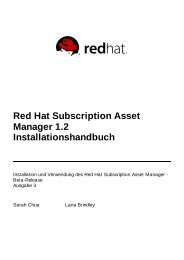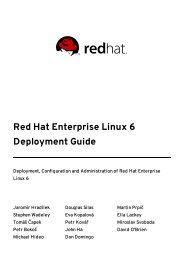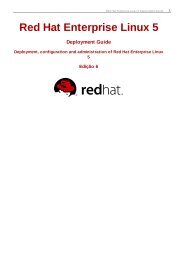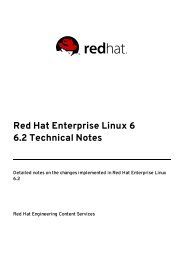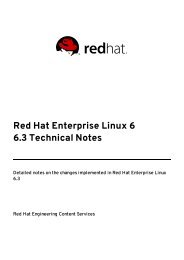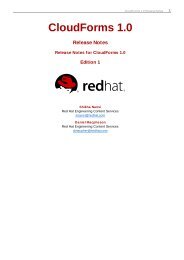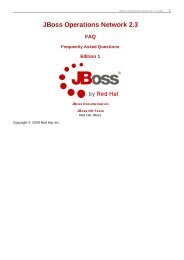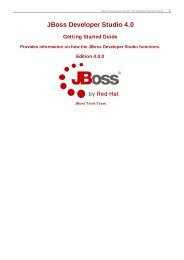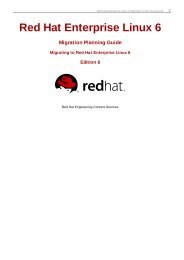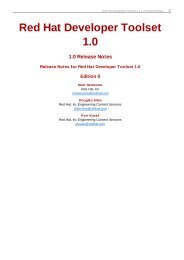JBoss Enterprise Application Platform Common Criteria Certification ...
JBoss Enterprise Application Platform Common Criteria Certification ...
JBoss Enterprise Application Platform Common Criteria Certification ...
You also want an ePaper? Increase the reach of your titles
YUMPU automatically turns print PDFs into web optimized ePapers that Google loves.
4 2 Chapter 6. The JNDI Naming Service<br />
An application component environment is a local environment that is accessible only by the component<br />
when the application server container thread of control is interacting with the application component.<br />
This means that an EJB Bean1 cannot access the ENC elements of EJB Bean2, and vice versa.<br />
Similarly, Web application Web1 cannot access the ENC elements of Web application Web2 or Bean1 or<br />
Bean2 for that matter. Also, arbitrary client code, whether it is executing inside of the application server<br />
VM or externally cannot access a component's java:comp JNDI context. The purpose of the ENC is to<br />
provide an isolated, read-only namespace that the application component can rely on regardless of the<br />
type of environment in which the component is deployed. The ENC must be isolated from other<br />
components because each component defines its own ENC content. Components A and B, for example,<br />
may define the same name to refer to different objects. For example, EJB Bean1 may define an<br />
environment entry java:comp/env/red to refer to the hexadecimal value for the RGB color for red,<br />
while Web application Web1 may bind the same name to the deployment environment language locale<br />
representation of red.<br />
There are three commonly used levels of naming scope in <strong>JBoss</strong>: names under java:comp, names<br />
under java:, and any other name. As discussed, the java:comp context and its subcontexts are only<br />
available to the application component associated with that particular context. Subcontexts and object<br />
bindings directly under java: are only visible within the <strong>JBoss</strong> server virtual machine and not to remote<br />
clients. Any other context or object binding is available to remote clients, provided the context or object<br />
supports serialization. You'll see how the isolation of these naming scopes is achieved in the<br />
Section 6.2, “The <strong>JBoss</strong> Naming Service Architecture”.<br />
An example of where the restricting a binding to the java: context is useful would be a<br />
javax.sql.DataSource connection factory that can only be used inside of the <strong>JBoss</strong> server where<br />
the associated database pool resides. On the other hand, an EJB home interface would be bound to a<br />
globally visible name that should accessible by remote client.<br />
6.6.1. ENC Usage Conventions<br />
JNDI is used as the API for externalizing a great deal of information from an application component. The<br />
JNDI name that the application component uses to access the information is declared in the standard<br />
ejb-jar.xml deployment descriptor for EJB components, and the standard web.xml deployment<br />
descriptor for Web components. Several different types of information may be stored in and retrieved<br />
from JNDI including:<br />
Environment entries as declared by the env-entry elements<br />
EJB references as declared by ejb-ref and ejb-local-ref elements.<br />
Resource manager connection factory references as declared by the resource-ref elements<br />
Resource environment references as declared by the resource-env-ref elements<br />
Each type of deployment descriptor element has a JNDI usage convention with regard to the name of the<br />
JNDI context under which the information is bound. Also, in addition to the standard<br />
deploymentdescriptor element, there is a <strong>JBoss</strong> server specific deployment descriptor element that<br />
maps the JNDI name as used by the application component to the deployment environment JNDI name.<br />
6.6.1.1. Environment Entries<br />
Environment entries are the simplest form of information stored in a component ENC, and are similar to<br />
operating system environment variables like those found on Unix or Windows. Environment entries are a<br />
name-to-value binding that allows a component to externalize a value and refer to the value using a<br />
name.<br />
An environment entry is declared using an env-entry element in the standard deployment descriptors.<br />
The env-entry element contains the following child elements:<br />
An optional description element that provides a description of the entry<br />
An env-entry-name element giving the name of the entry relative to java:comp/env<br />
An env-entry-type element giving the Java type of the entry value that must be one of:<br />
java.lang.Byte<br />
java.lang.Boolean<br />
java.lang.Character<br />
java.lang.Double<br />
java.lang.Float



